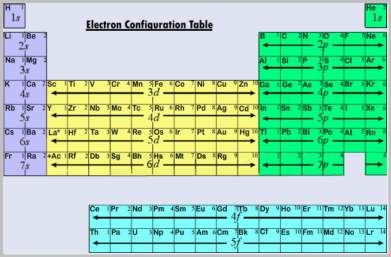Every atom contain a nucleus which contains protons and usually neutrons. Electrons orbit the nucleus in an electron “cloud” at different energy levels. An electron cloud is divided into atomic orbitals which are just the locations where certain electrons are most likely to be found. To understand the significance of these energy levels, it is crucial to understand a little about the nature of protons and electrons.
The nucleus of an atom contains protons that had a positive charge and neutrons that have no charge. Since the neutrons do not have a charge, only the protons contribute to the charge of the nucleus; therefore, every atomic nucleus has a positive charge. On the other hand, the electrons orbiting the nucleus have a negative charge. Just as opposite poles of magnets attract, so do electrical charges so there is an electrical attractive force between the protons and electrons of an atom. However, just as the attraction between magnets decreases with distance, the attraction between electrons and protons also decreases as the distance between them increases. Thus, the significance of the energy levels in electron clouds becomes evident – as an electrons enter energy levels farther and farther away from the nucleus of an atom, the attraction between the nucleus and electrons decreases.
In an atom, the first electron shell is the closest to the atom’s nucleus and contains only one spherical orbital called 1s. The second electron shell is just outside the first but contains four orbitals: one 2s orbital and three 2p orbitals. Again the s orbital is spherical; however, the P orbitals are shaped much like tear droplets connected at the pointy ends; that is, the p orbitals display a dumbbell-like shape. Since electrons all have the same negative charge, they repulse each other, and as a result, the P orbitals remain as far apart from each other as possible while remaining in the given energy level.
The three 2P orbitals are all of equal energy, and such orbitals occurring at the same energy level are called degenerate orbitals. The orbitals continue: 1s, 2s, 2p, 3s, 3p, 3d, 4s, 4p, 4d, 4f, 5s, 5p, 5d, 5f, 6s, 6p, and 7s. Two electrons can fill each s orbital, six can fill each p orbital, ten can fill each d orbital, and fourteen electrons fill each f orbital.
In an electron configuration chart, the numbers that come before the letters indicate the energy level of the orbital; for example, 1s refers to the lowest energy s orbital, 2s refers to the second lowest energy s orbital, and 3p refers to the third lowest energy p orbital. Subsequently, the letters refer to the type of orbital, that is, there are s, p, d, and f orbitals each of which can hold up to 2,6, 10, and 14 electrons respectively. Next, an exponent is written on the orbital letter. The exponent indicates the number of electrons in the particular orbital; that is, 1s^2 means that there are two electrons in the 1s orbital, and 2p^5 means that there are five electrons in the 2p orbital. Often, electron configuration charts will have pairs of single-headed arrows corresponding to the orbitals. Each arrow merely represents an electron, and the direction of the arrow indicates the electron’s “spin” – either up or down.
Electrons must conform to certain laws when they are filling their orbitals. The first of these is called Aufbau’s Principle which states that lower energy orbitals are filled before higher energy orbitals. That is, the 1s orbital must be completely filled before an electron enters the 2s orbital, the 2s orbital must be completely filled before an electron enters the 2p orbital and so on.
Next, the Pauli exclusion principle states that only two electrons may be placed in a particular orbital, and those electrons must possess opposite spins. Thus, only two electrons can enter each of the three 2p orbitals, and whenever one electron in an orbital has an “upward” spin, the other must have a downward spin.
The final law of electron configurations is called Hund’s Rule. This law states that when orbitals of equal energy are being filled, each orbital must have an electron in it before an orbital may have two electrons in it. For example, if the 2p orbital is being filled, each of the three orbitals within it must receive an electron before the first orbital may receive a second electron.
Sources:
Metcalfe, H. Clark., John E. Williams, and Joseph F. Castka. Modern Chemistry. New York: Holt, Rinehart and Winston, 1982. Print.
Solomons, T. W. Graham., and Craig B. Fryhle. Organic Chemistry. Hoboken, NJ: Wiley, 2010. Print.


